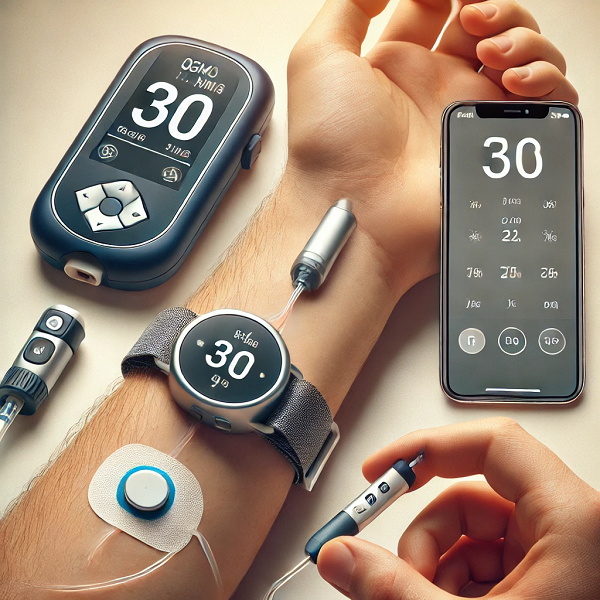
Diabetes is a condition that affects how your body handles sugar, and it requires careful management. While it used to be tough for people with diabetes to manage their blood sugar levels, modern technology is making it a lot easier. Today, new inventions and treatments are helping people with diabetes live healthier and more independent lives. Let’s explore some of the latest advances in diabetes technology and treatments that are changing the way people manage their condition.
Continuous Glucose Monitors (CGMs)
One of the biggest breakthroughs in diabetes technology is the Continuous Glucose Monitor (CGM). If you have diabetes, you have to check your blood sugar a lot, and in the past, this meant pricking your finger many times a day. With a CGM, you wear a small sensor on your body that checks your blood sugar levels every few minutes. The sensor sends this information to a device like your phone or a special monitor. This way, you always know your levels without having to poke yourself.
CGMs not only make life easier, but they also help people make better decisions about their health. When you know what your blood sugar is at all times, you can adjust what you eat, how much insulin you take, or how much you exercise. This keeps your levels more stable and can prevent complications. Some CGMs even alert you if your blood sugar gets too high or too low, which can be life-saving.
Insulin Pumps
Another incredible advancement in diabetes care is the insulin pump. Instead of taking insulin shots throughout the day, people with diabetes can wear a small device that delivers insulin through a tiny tube. The pump gives insulin continuously, just like a healthy pancreas would. This helps people with diabetes manage their blood sugar levels more effectively.
The best part about some new insulin pumps is that they can now “talk” to CGMs. These smart pumps adjust the amount of insulin you get based on your blood sugar levels. This is sometimes called a closed-loop system or an “artificial pancreas.” It’s a major improvement because it helps keep blood sugar levels in a healthier range without as much effort from the person using it.
Smart Pens
Smart insulin pens are another cool new device for people with diabetes. These pens are used to inject insulin, but they’re different from regular insulin pens because they track how much insulin you take and when. The pen connects to an app on your phone, so you always know if you’ve taken your insulin and if you need more. It also helps you calculate the right dose based on your blood sugar levels and what you’re eating.
This is especially helpful for people who might forget if they’ve taken their insulin or who need help figuring out the right dose. By taking out the guesswork, smart pens make managing diabetes easier and safer.
New Medications
In addition to better devices, there have also been advances in diabetes medications. For example, some new drugs, like SGLT2 inhibitors, help the kidneys remove extra sugar from the body through urine. Other medications, like GLP-1 receptor agonists, help people produce more insulin after they eat and help keep blood sugar levels from rising too high.
These new drugs are especially helpful for people with type 2 diabetes because they offer more options for controlling blood sugar. Many of them also have added benefits, like helping people lose weight or improving heart health, which is important for people with diabetes.
Artificial Pancreas
The artificial pancreas is an exciting development that combines a CGM and an insulin pump into one system. The goal of an artificial pancreas is to automatically monitor blood sugar levels and give the right amount of insulin, just like a real pancreas does in people without diabetes. This system helps to take a lot of the burden off the person with diabetes because it does the work for them.
While it’s not yet perfect, the artificial pancreas is a big step toward making diabetes management easier. Right now, several versions are available that still require some input from the user, but in the future, fully automated systems could be a reality.
Telemedicine and Diabetes Care
Telemedicine has also become an important part of diabetes treatment, especially after the COVID-19 pandemic. With telemedicine, people can talk to their doctors and diabetes specialists from home using video calls or apps. This is convenient for people who live far away from their doctors or who can’t make it to the office as often.
Telemedicine also makes it easier for doctors to keep track of their patients’ health. People can upload their blood sugar readings, insulin doses, and other important information to an app, and their doctors can review it and make changes to their treatment plans if needed. This kind of care is more flexible and can lead to better health outcomes.
Advances in Diabetes Education and Support
Technology isn’t just about gadgets and medications; it’s also about making sure people with diabetes have the right information. New apps and websites offer diabetes education and support, which can help people learn how to manage their condition better. These tools provide tips on what to eat, how to exercise, and how to take care of their overall health.
There are even online communities where people with diabetes can connect, share their experiences, and give each other support. This is especially important because managing diabetes can sometimes feel lonely or overwhelming.
Future Possibilities: Diabetes Cures?
While there is no cure for diabetes yet, scientists are always working on new treatments. Some exciting research is being done on beta-cell replacement therapy, which would replace the insulin-producing cells in the pancreas. There’s also research into gene therapy, which could one day help the body make its own insulin again. Although these treatments are still in the experimental phase, they offer hope for a future where diabetes might be easier to manage—or even cured.
The latest advances in diabetes technology and treatments are truly amazing. From CGMs and insulin pumps to smart pens and new medications, people with diabetes have more options than ever before. These new tools make managing diabetes easier, safer, and more effective. And with even more exciting developments on the horizon, the future looks brighter for people living with diabetes.
Whether you’re using a CGM to monitor your blood sugar or taking advantage of telemedicine, these advances show how technology is improving lives. While we may not have a cure yet, the progress being made is incredible. Managing diabetes is becoming less about struggle and more about living well.
#diabetes #diabetestechnology #insulinpumps #continuousglucosemonitor #artificialpancreas #smartpens #newmedications #diabetesmanagement #telemedicine #type2diabetes

